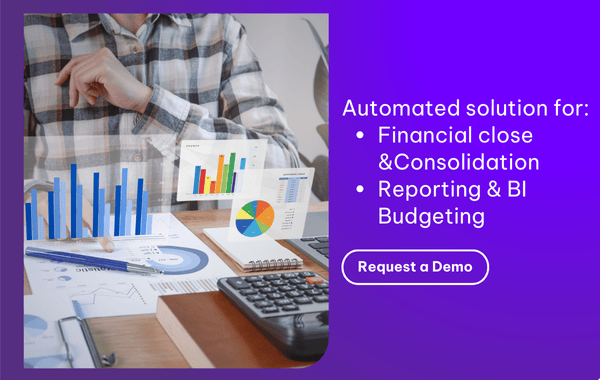What enterprises today have an abundance of are pressures. For instance, the pressure of addressing challenges associated with planning and distributing budget rationally, or the pressure of finding an optimal financial solution.
Forward-looking CFOs have shifted away from traditional spreadsheets to a more sophisticated solution that can enable them to make more informed decisions based on real-time data and insights.

During this particular turbulent, highly complex environment like today, CFOs need more flexibility, visibility and better analysis tools, something that can only be done by leveraging a comprehensive planning and budgeting solution.
With how technologies advance today, there already is an endless array of products to suit every budget and need. This begs the question: Where to start? What to look for in a planning and budgeting solution to achieve optimal efficiency.
Read more: 7 Worst Financial Fiascos Caused by Excel Errors
Why do you need a planning and budgeting solution?
Planning is the process of setting up short and long-term targets for business to achieve in the future. Budgeting allows finance directors to allocate financial sources reasonably depending on the business' demands. They ensure businesses reach their goals as well as maximise their utilisation of resources for each fiscal year.
Planning and budgeting provide valuable insights for managing risk, boosting corporate performance and shareholder value and making strategic decisions. Using a business model as the basis of the planning process enables the development of charts of accounts; time divided by years/ quarters/ months; version control to store actuals/budgets/forecasts and other important data segments, which can be used to create the plans.
Organisations should look for financial planning and budgeting solutions capable of delivering flexible business models that are mapped to their unique business requirements.
An effective planning solution can help eliminate a lot of manual effort and ensure accuracy when linking financial statements and allocation routines.
The key to an efficient planning and budgeting application is to enable the creation of financial and operational plans with less effort, more accuracy and a greater degree of flexibility to reflect any changes to the business.
- Flexibility: enables the planning process to incorporate multiple scenarios, which is essential as companies move from a short-term towards a long-term perspective.
- Technology: expedites this process by reducing the role of the middleman and empowering business users to expand and maintain their applications on their own.
- Collaboration: creates opportunities for collaboration through web-based access to plans and data in a central data centre. This information can be later used for budgeting, forecasting, reporting, and analysis.
Read more: Will Smart Technologies Replace CFOs?
How to select a suitable planning and budgeting solution for your company?
1. Mobility
Mobility should be one of your priorities when selecting financial solutions. There is no doubt in denying the benefits that come with flexibly and conveniently accessing data on your smartphone, generating reports, analysing, forecasting and budgeting while on the go, without wasting your time waiting for the data to be imported, particularly during this work-from-anywhere era.
Subsequently, this can lead to enhanced productivity and efficiency, reduced paperwork, company resources, and a faster decision-making process based on timely and relevant insights. It also empowers employees to work independently and proactively.
2. Big data governance
Approximately 50% of businesses nowadays struggle with the increasing volume of customers’ data, which leads to the state of storage shortage. Hence, the need for big data management tools becomes essential more than ever. Leveraging the right tool can enable organisations to access relevant and make informed decisions, while at the same time, reducing the time and costs associated with organising and managing data.
According to HBR research, data-driven businesses achieved 5% more productivity and 6% more profitability compared to competitors. Since finance directors are able to make appropriate decisions to better respond to market changes based on an up-to-date and accurate database. Big data governance software is equipped with a solid security system to ensure your information security as well as reduce the risk of data loss by storing a backup for vital information.
Big data management combined with a Business Intelligence tool enables businesses to better manage, process, and understand the growing information. With comprehensive data-driven tools, finance directors are able to make quicker decisions as well as more accurate forecasting.
3. Forecasting capability
Alongside with planning, reporting and budgeting functions, forecasting capability with high accuracy is the next crucial factor CFOs must look for in quality financial software. A suitable solution, along with reliable data, can provide you with a quick snapshot into the future, and enable you to forecast cash flow, profit and loss, sales and revenues and the like.
The function then visualises data and presents CFOs with an overview of the company's current financial situation, key business drivers and how the future should look like.
Therefore, a planning and budgeting solution with advanced forecasting capability allows businesses to access real-time data, uncover opportunities, lower financial risks and expenses, reduce manual work, and make more informed decisions.
Read more: What Does the Future Hold for Financial Forecasting?
4. System integration
A completely integrated platform allows transferring a high volume of data from one module to another automatically without the manual effort of coding the same data twice. It increases the availability and up-to-date features of data flow and allows employees to do advanced financial works, which a standalone system cannot, such as estimating project costs or sale commissions.
Read more: How Does Integration between ERP and EPM Work?
Before making a purchasing decision, CFOs need to understand what features your business wants to possess besides the primary functions. Yet, the typical integrated system will allow hosting different applications and storing high-volume of data without the issue of data duplication and fragmentation.
5. Supporting services
Finally, after considering all of the above-mentioned features, be sure to not overlook the supporting services that software vendors offer to their customers. Unexpected incidents and issues will arise. The support from the vendors is crucial, especially offline support and if you are a non-technical user.
Infor Dynamic Enterprise Performance Management (Infor EPM) is known as an integrated planning, budgeting, forecasting, and financial consolidation solution. Infor d/EPM is equipped with loads of outstanding features, comprising Risk and compliance monitoring, P&L, balance sheet, cash flow planning, multi-currency and multiple conversion rates, what-if scenario planning, workflow managing and many more.
Take advantage of this powerful and user-friendly solution and empower your employees to deliver better, more accurate results in a much shorter time.
Request a demo for Infor d/EPM today.
 English
English  Vietnamese
Vietnamese 


